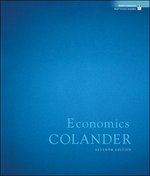Question
1.If the Central Bank decreases the money supply, it is conducting A) B) monetary policy.C)fiscal policy. supply-side policy.D)income policy. 2.Which of the following represents an
1.If the Central Bank decreases the money supply, it is conducting
A)
B)
monetary policy.C)fiscal policy.
supply-side policy.D)income policy.
2.Which of the following represents an action by the Central Bank that is designed to increase the money
A)
supply?
buying government securities in the open market
B) an increase in the required reserve ratio
C) a decrease in Central Bank spending D) an increase in the discount rate
3.If planned investment exceeds actual investment,
A)there will be an accumulation of inventories.
B)there will be no change in inventories.
C)
D)
there will be a decline in inventories.
none of the above
4.Which of the following is subtracted from national income to get to personal income?
A) retained earnings C) depreciation B) personal interest income D) personal Taxes
5.Which of the following is included in M2, but not included in M1?
A)
currency held outside banks
C)
demand deposits
B)
travelers checks
D)
savings accounts
6.In a closed economy with no government, aggregate expenditure is
A)
Consumption plus investment.
C)
Consumption plus the MPC.
B)
Saving plus investment.
D)
MPC + MPS.
7.Fiscal policy refers to
A)the techniques used by a business firm to reduce its tax liability.
B)the behavior of the nation's central bank, the Federal Reserve, regarding the nation's money supply.
C)the spending and taxing policies used by the government to influence the economy.
D)the government's ability to regulate a firm's behavior in the financial markets.
8.Output is determined in
A)the goods market and also influences money demand and the interest rate.
B)the money market and also influences money demand and the interest rate.
C)the goods market with no influence from the money market.
D)the money market with no influence on the goods market.
9.Which of the following sequence of events follows an expansionary fiscal policy?
A)
AE
Y
M
d
r
I
AE
C)
AE
Y
M
r
I
AE
.
d
.
B)
AE
Y
M
d
r
I
AE
D)
AE
Y
M
r
I
AE
.
d
.
10.An increase in aggregate demand when the economy is operating at full capacity is likely to result in
A)an increase in both output and the overall price level.
B)an increase in output but no increase in the overall price level.
C)an increase in the overall price level but no increase in output.
D)no increase in either output or the overall price level.
Step by Step Solution
There are 3 Steps involved in it
Step: 1

Get Instant Access to Expert-Tailored Solutions
See step-by-step solutions with expert insights and AI powered tools for academic success
Step: 2

Step: 3

Ace Your Homework with AI
Get the answers you need in no time with our AI-driven, step-by-step assistance
Get Started


